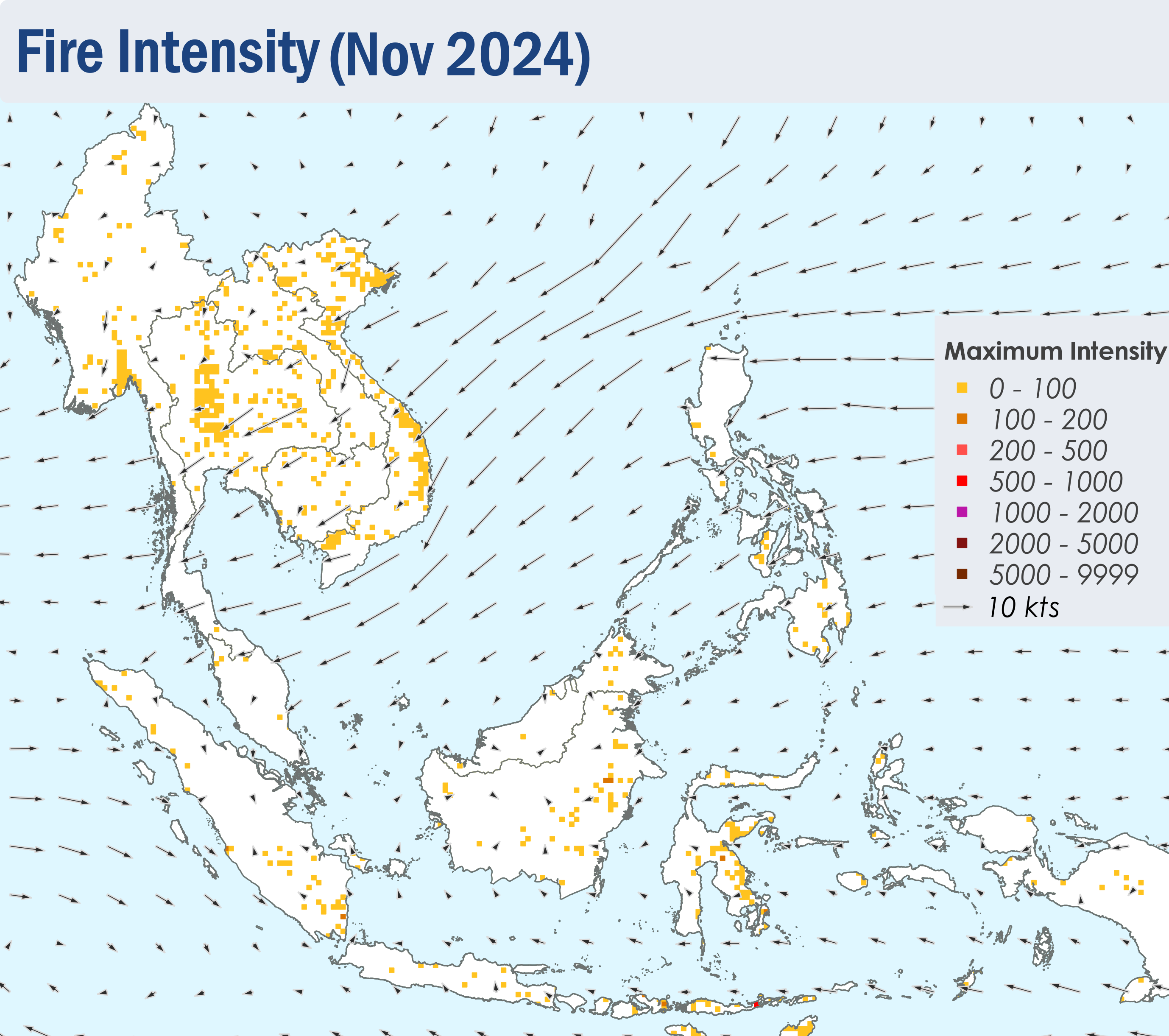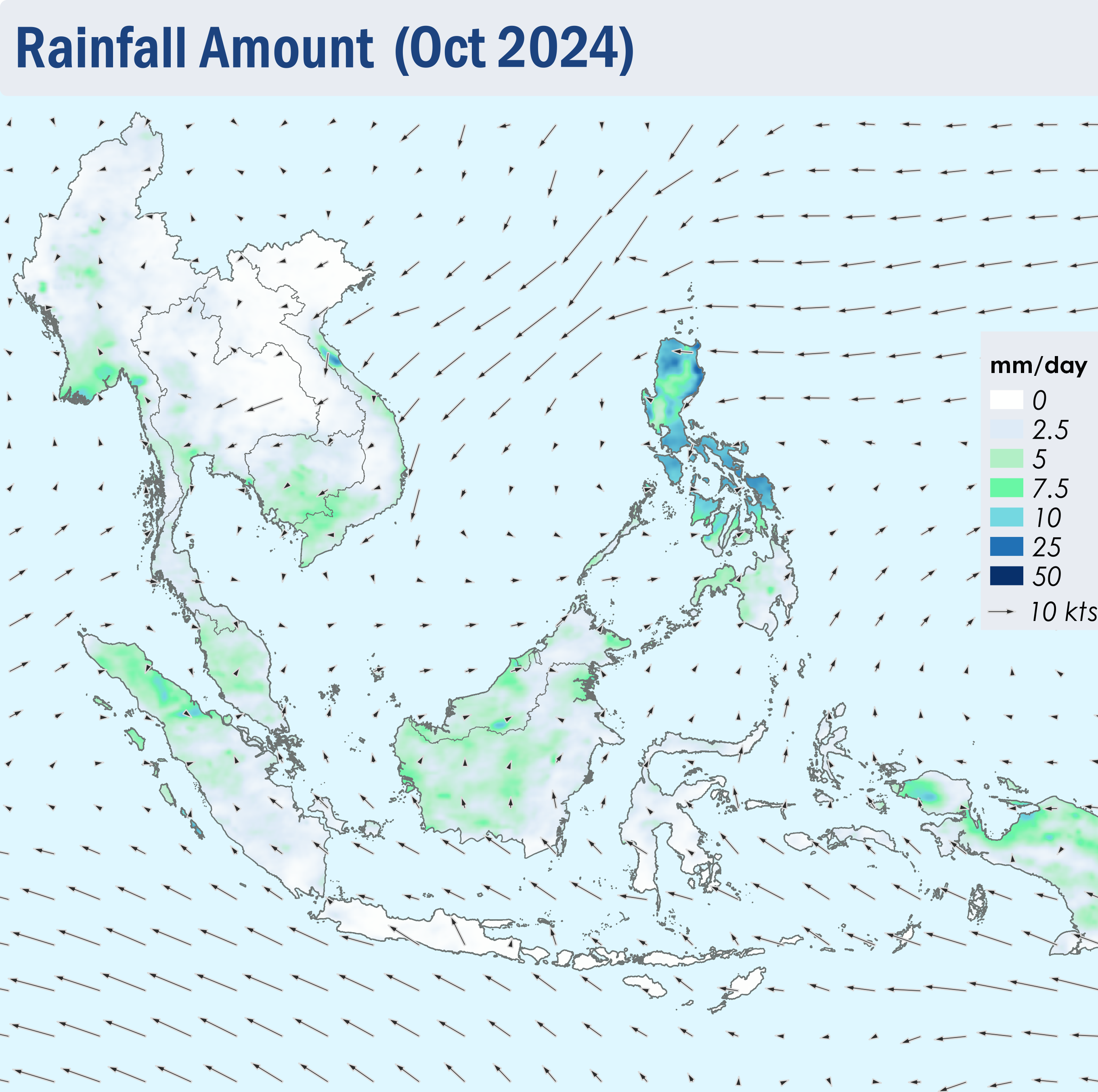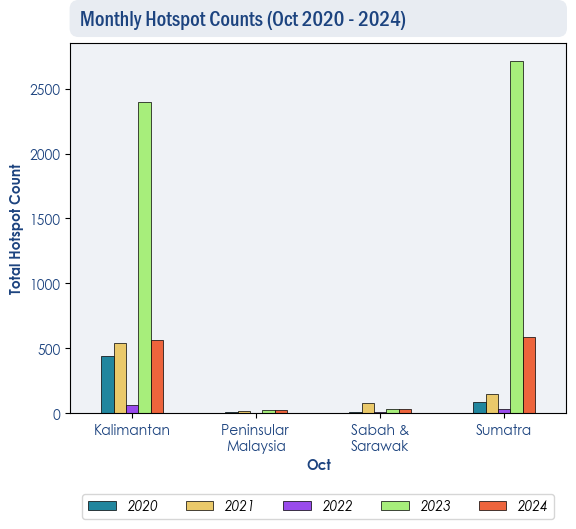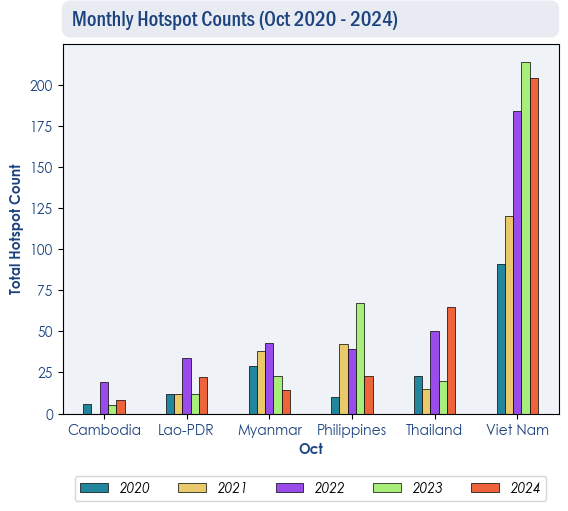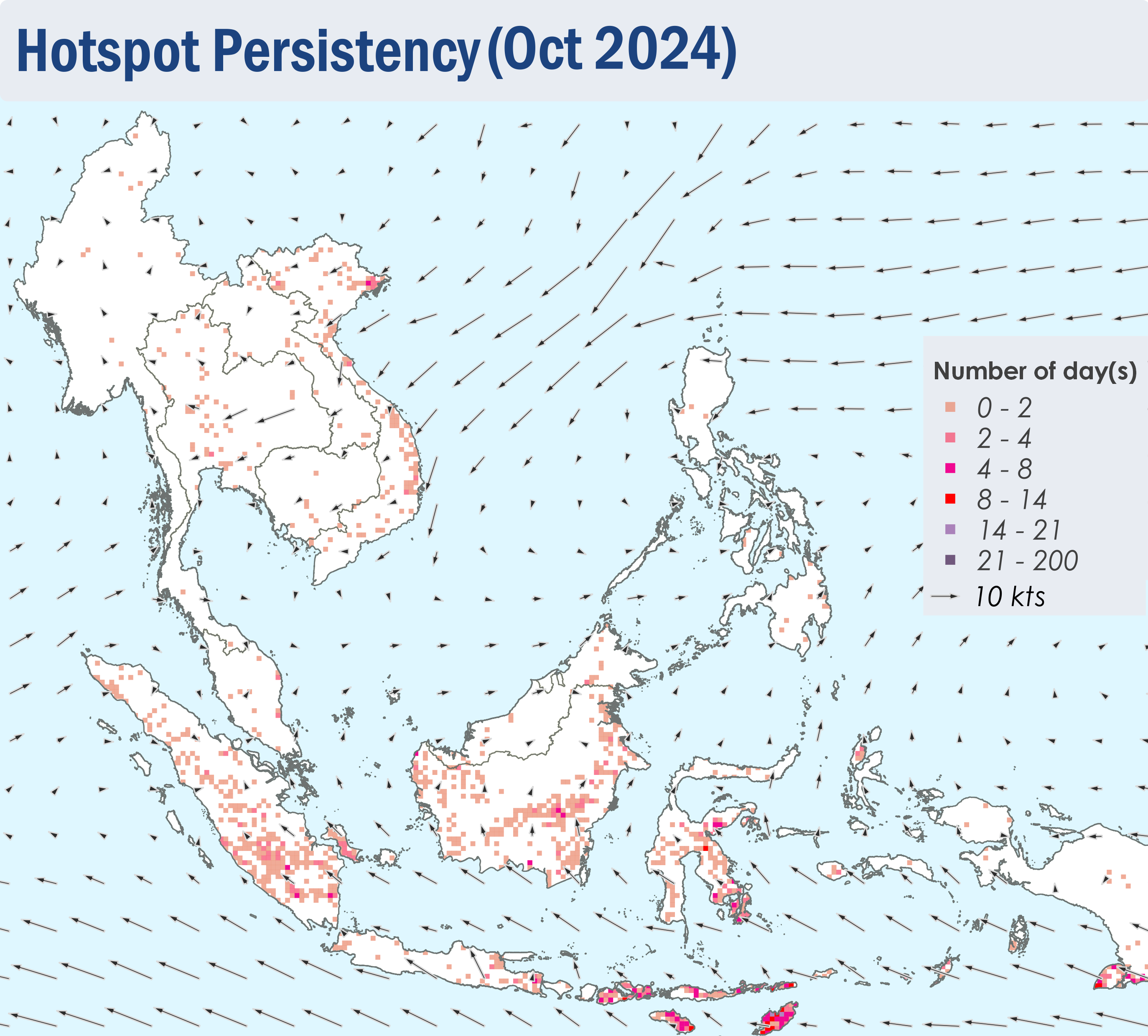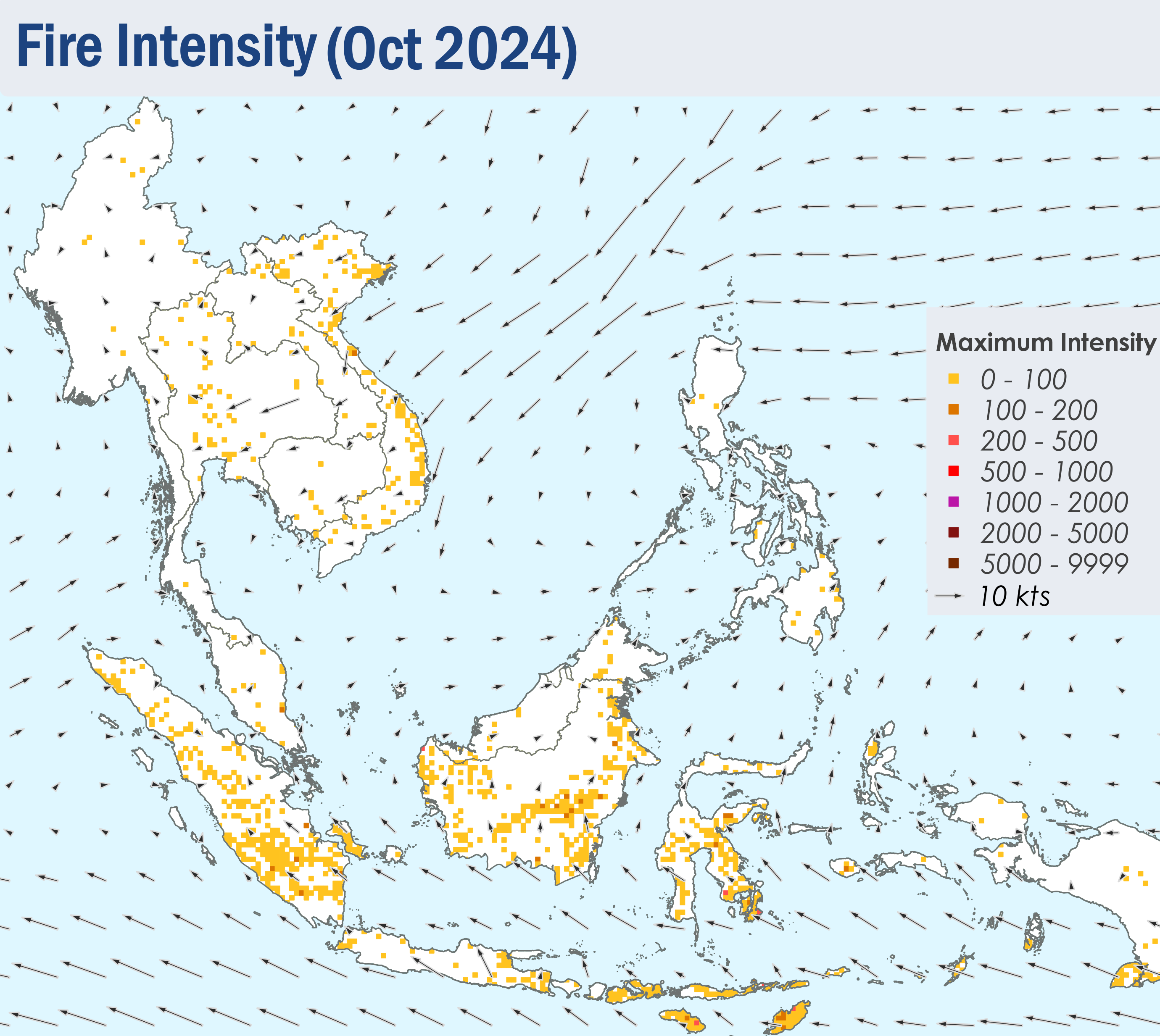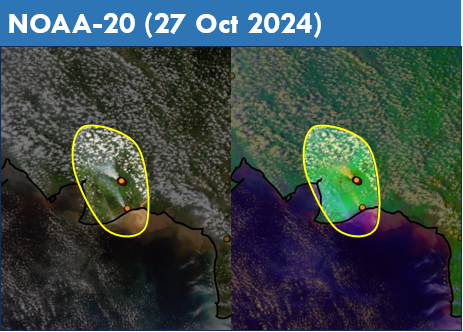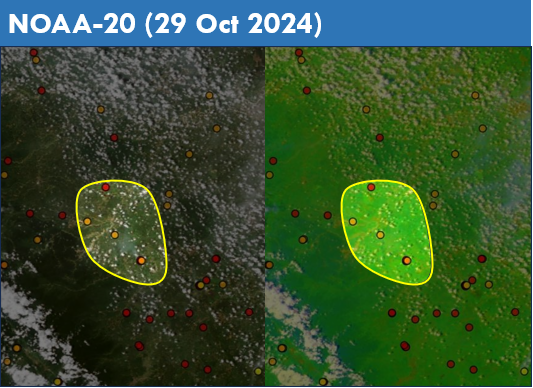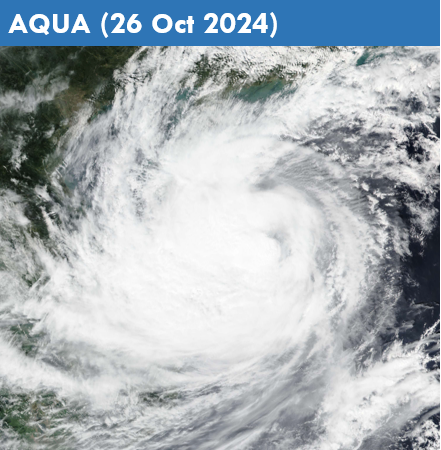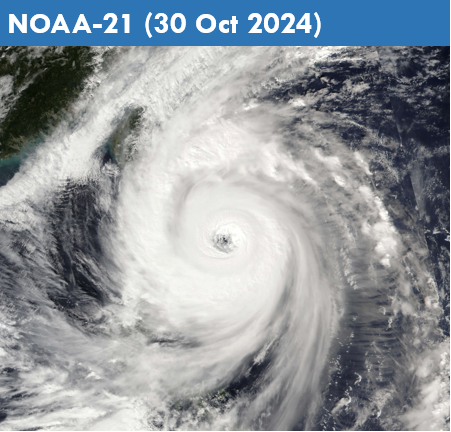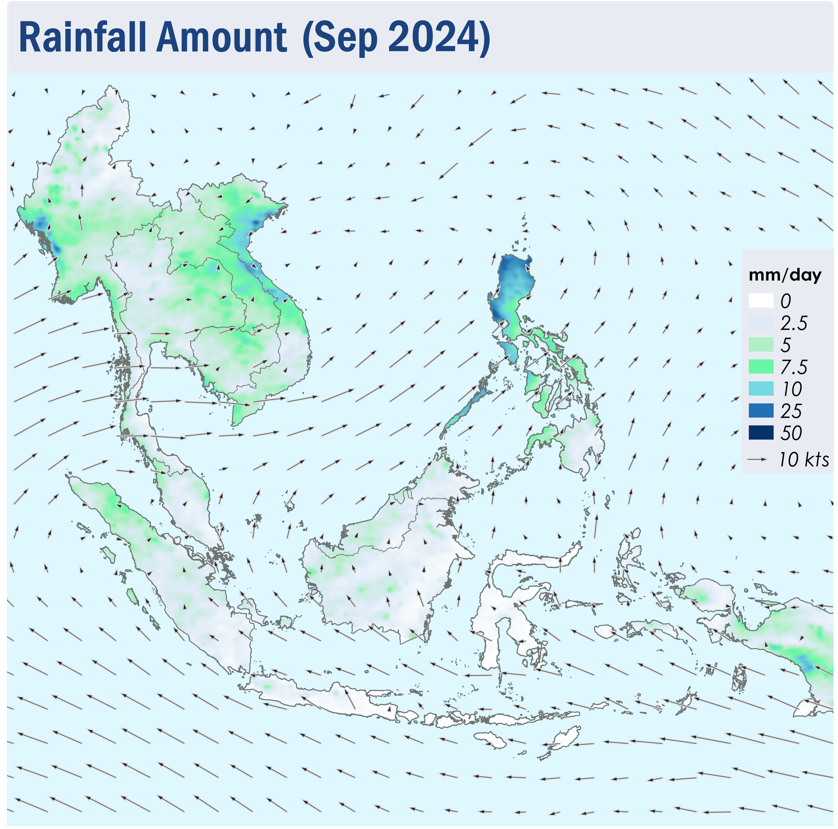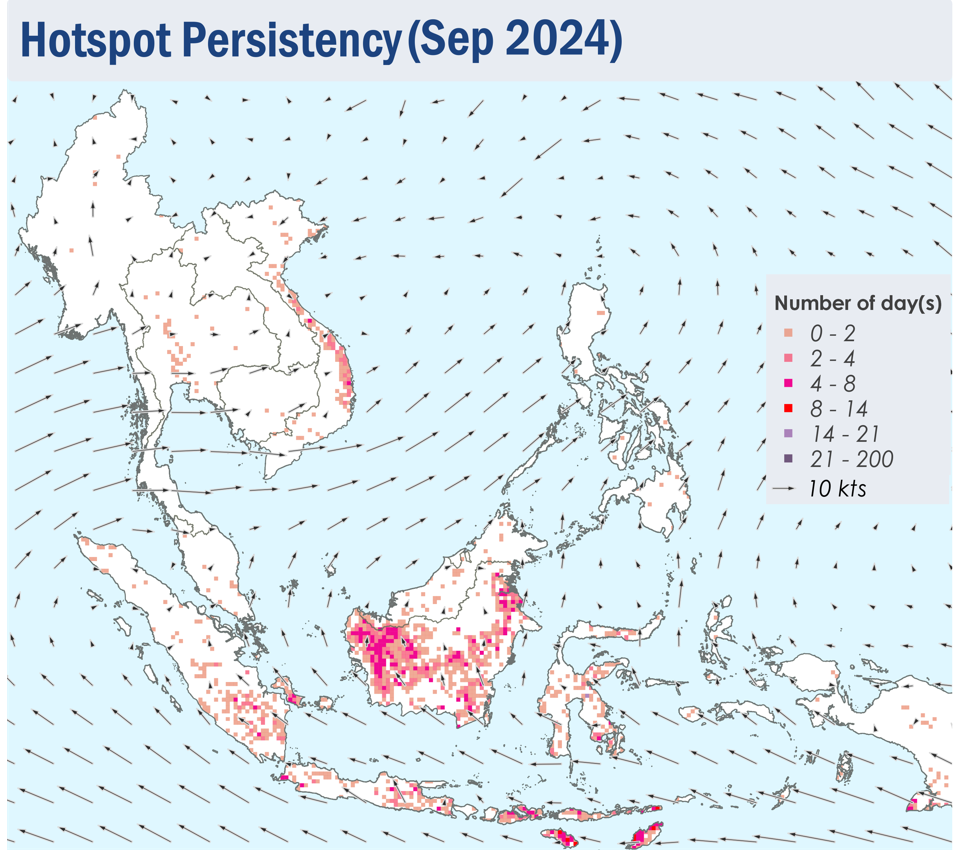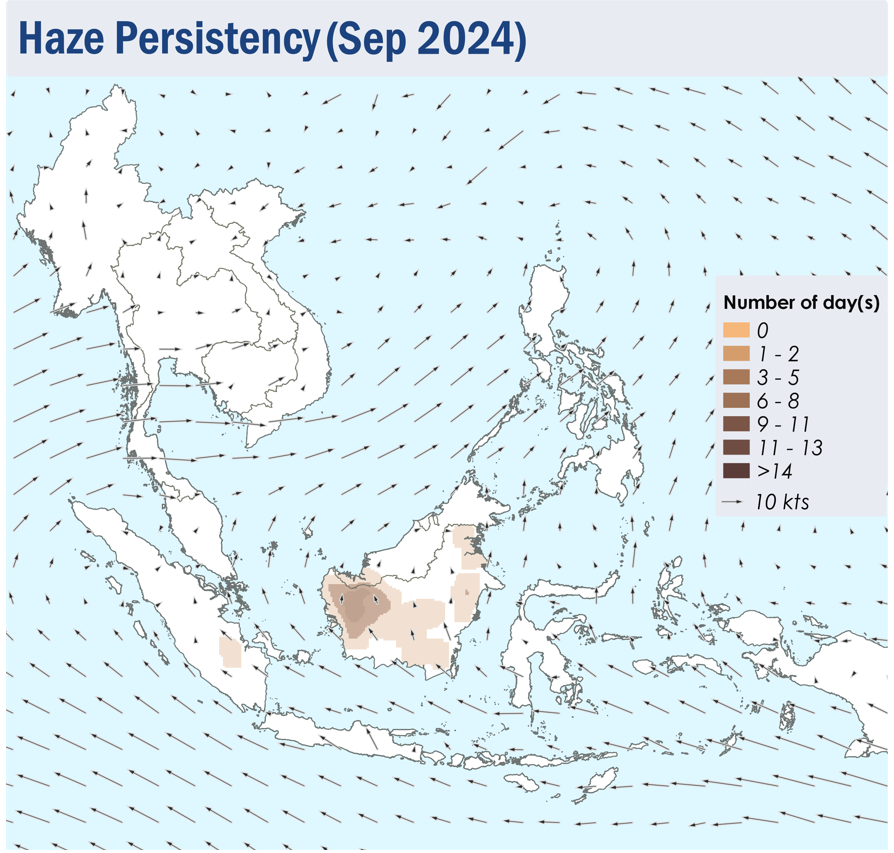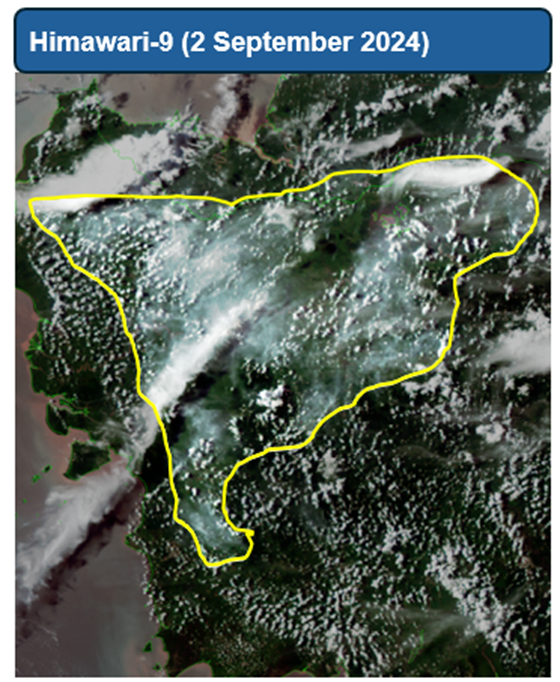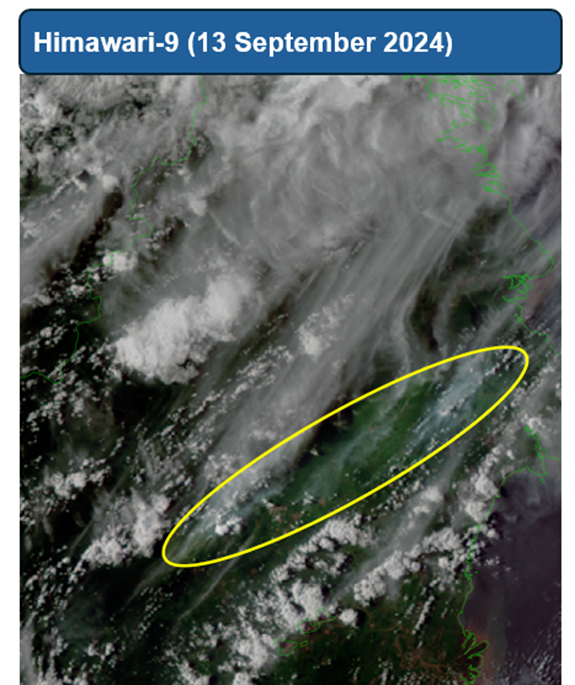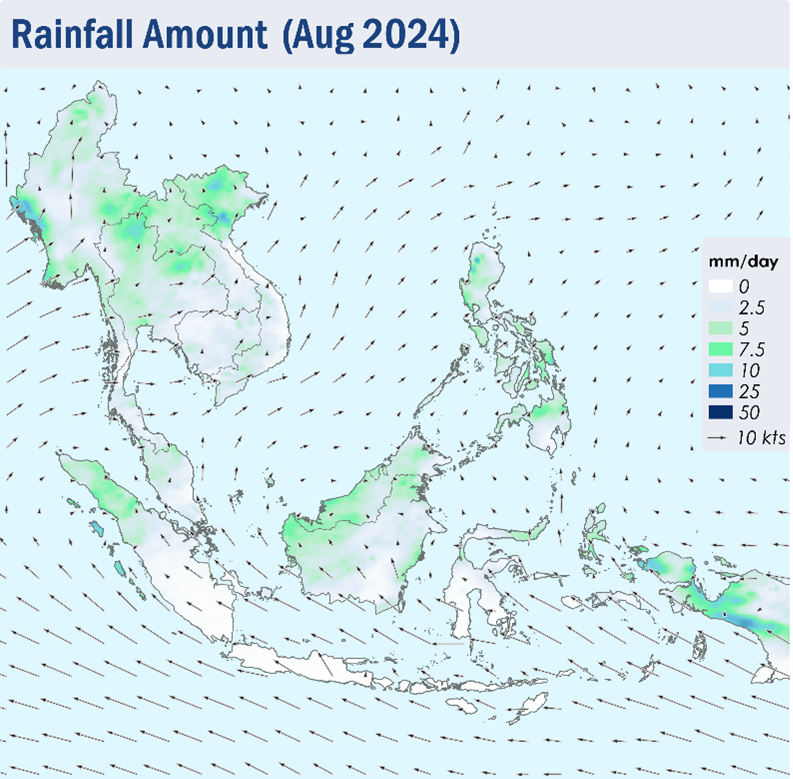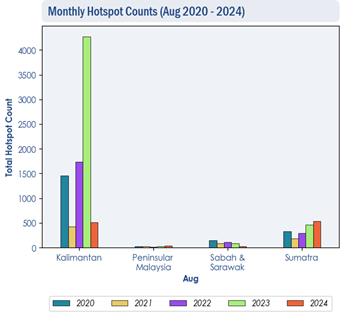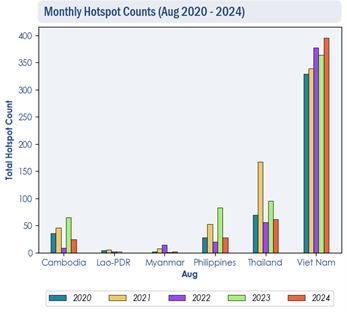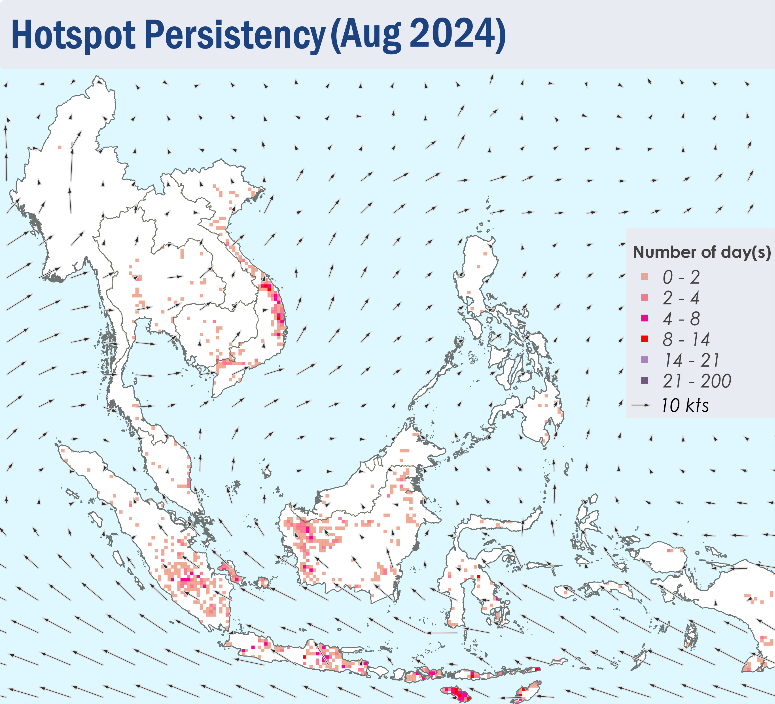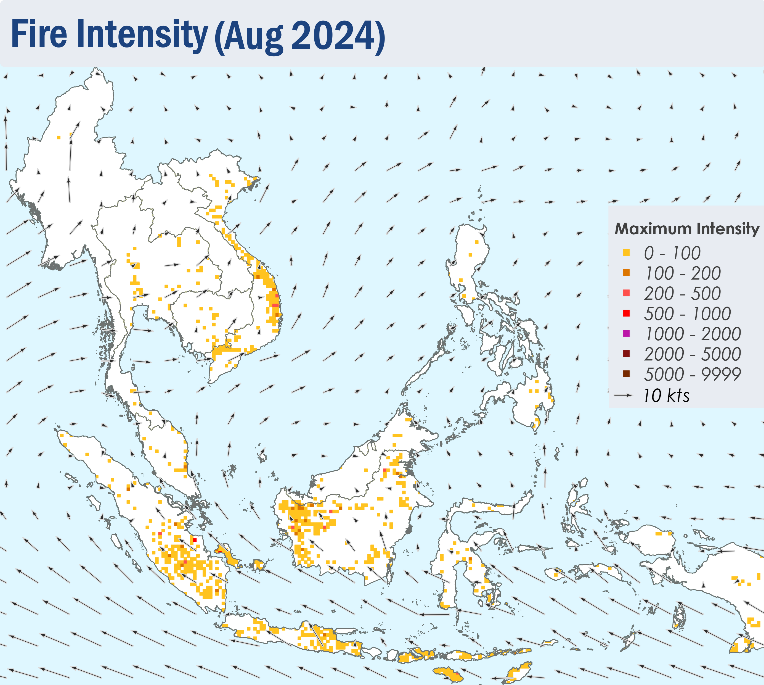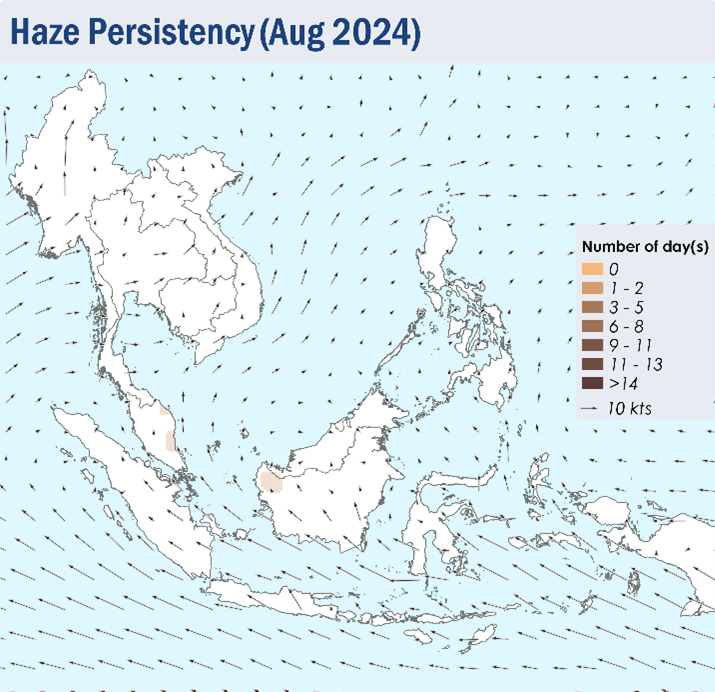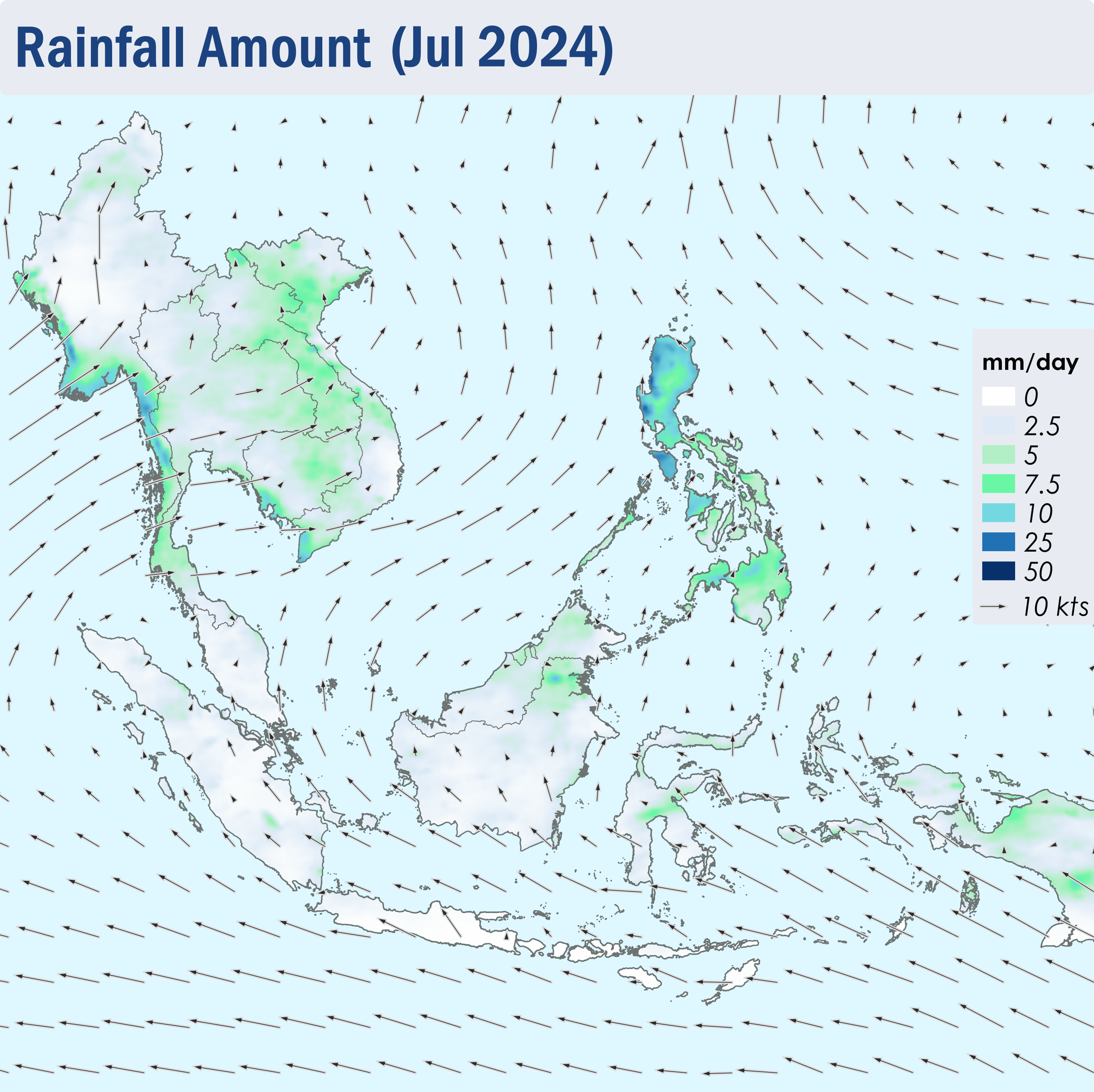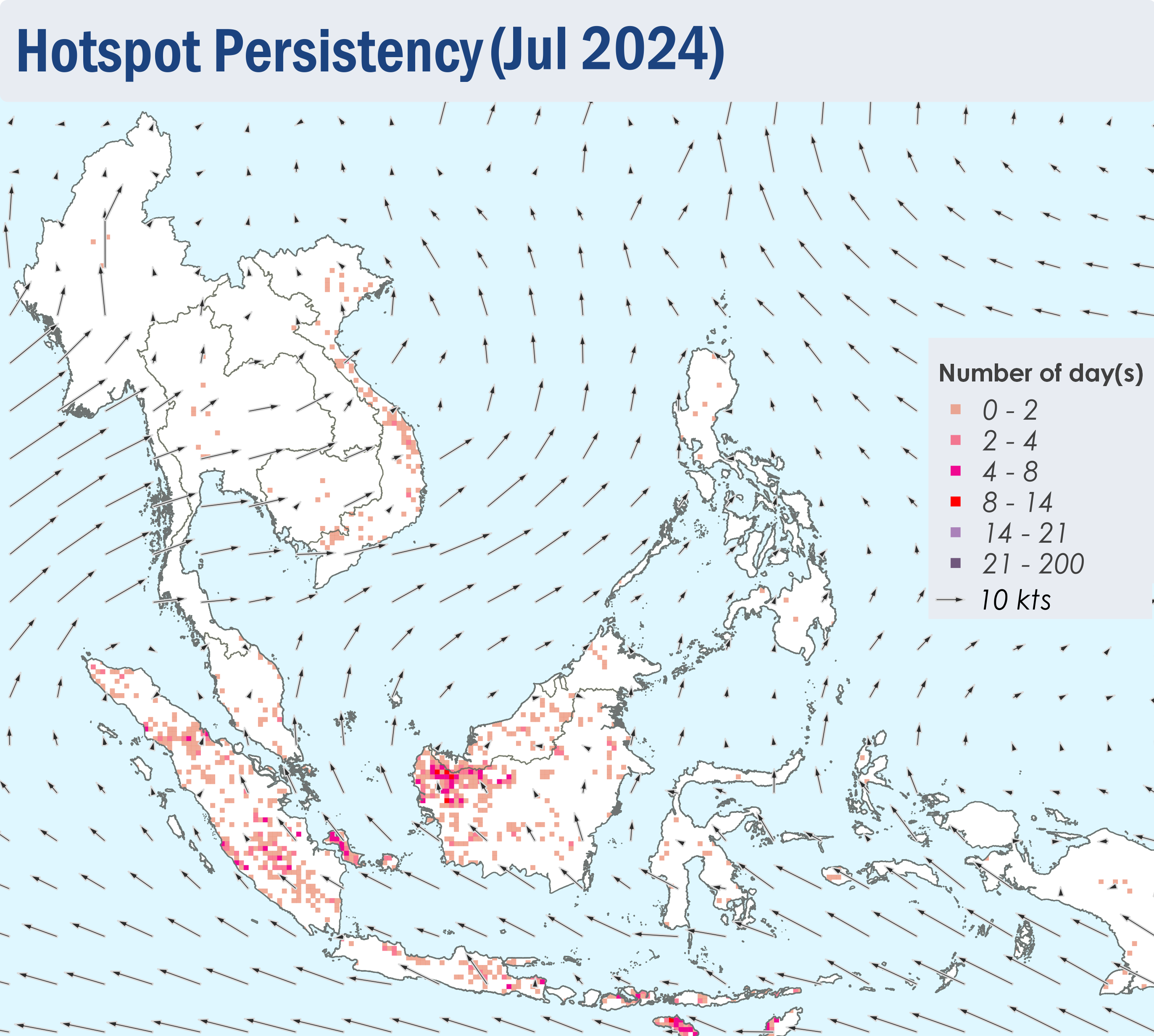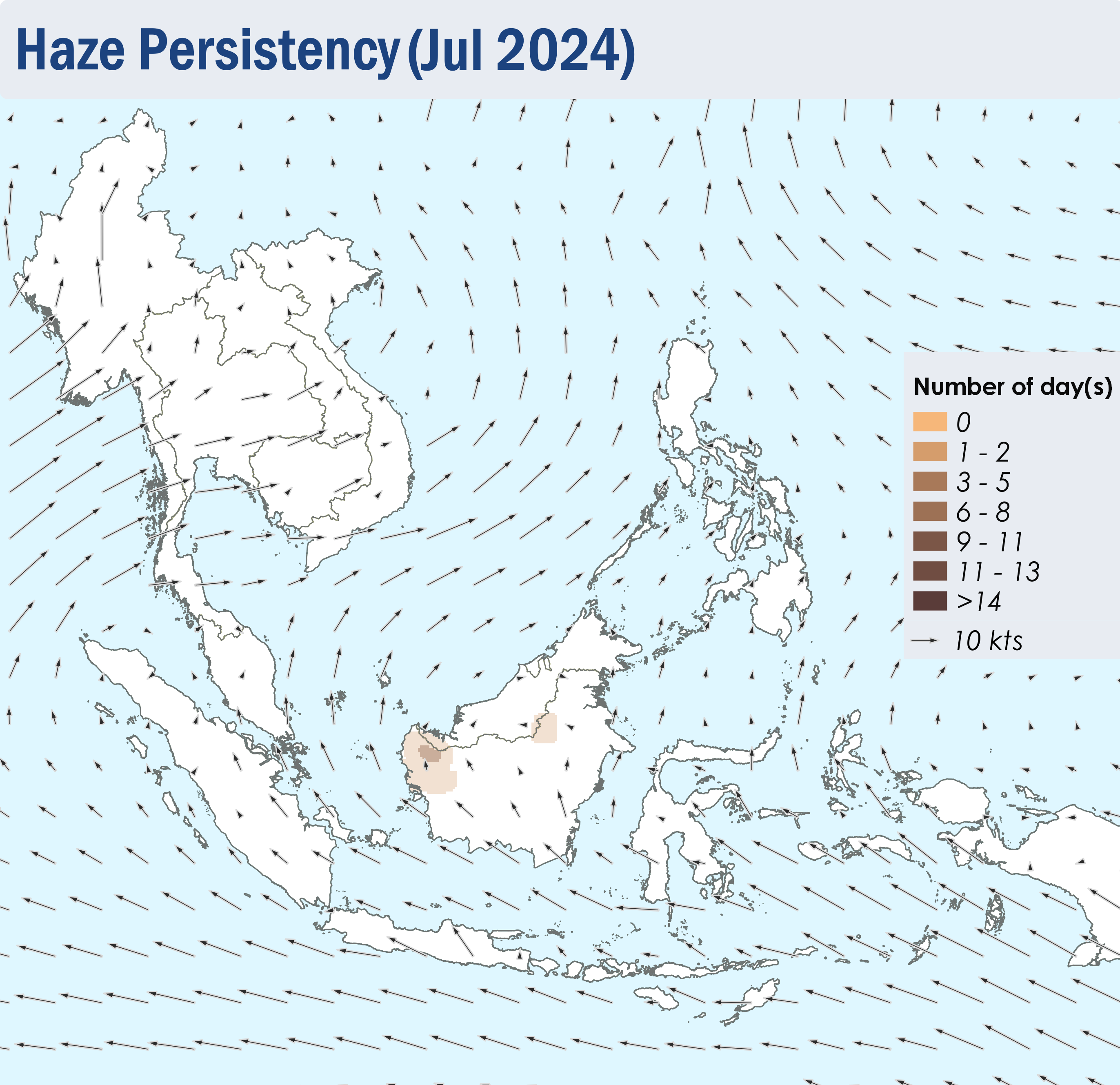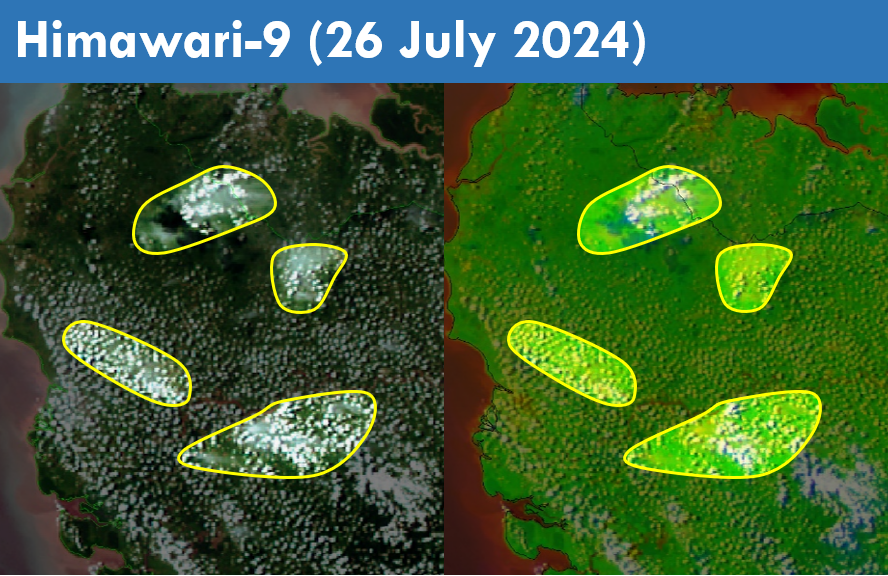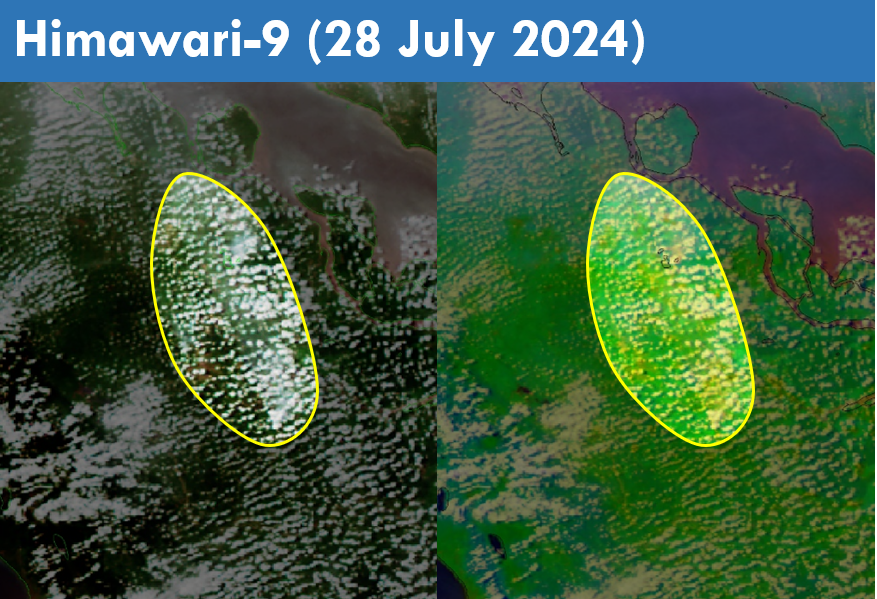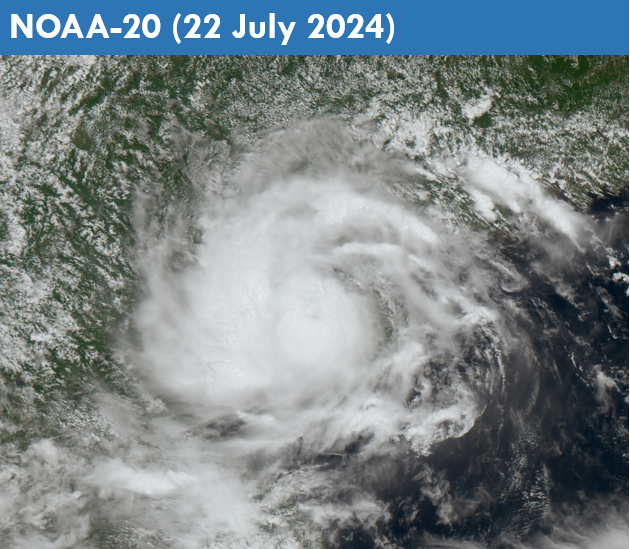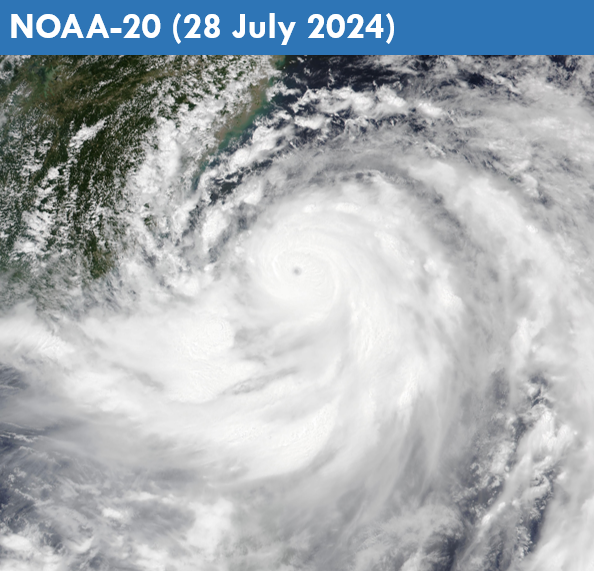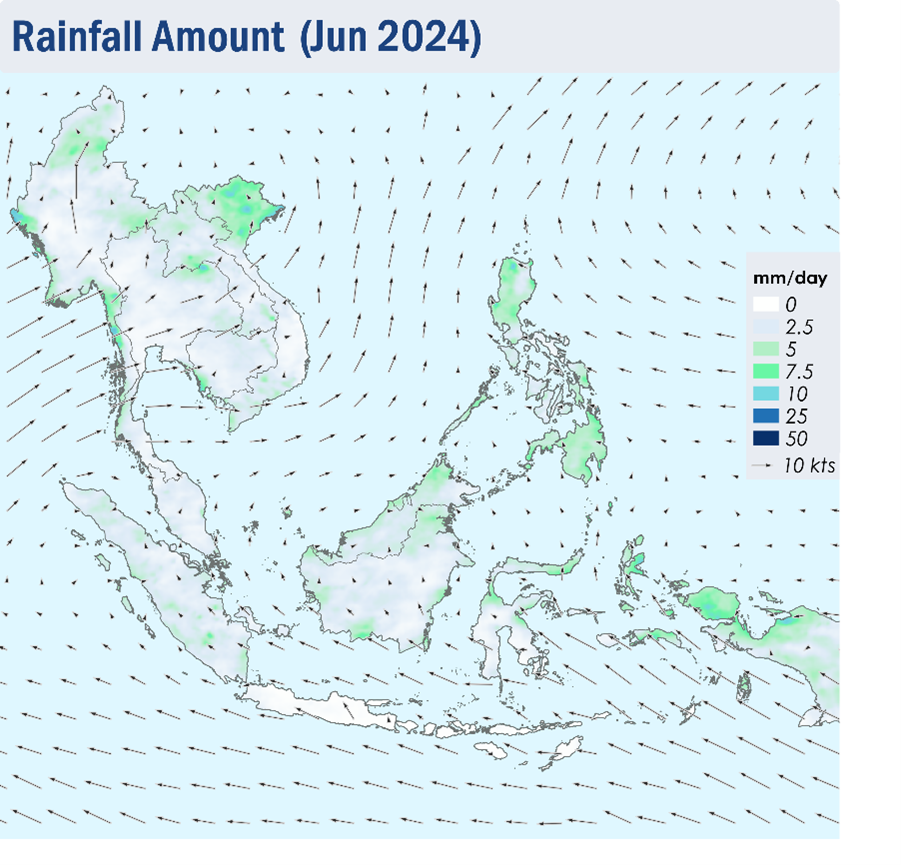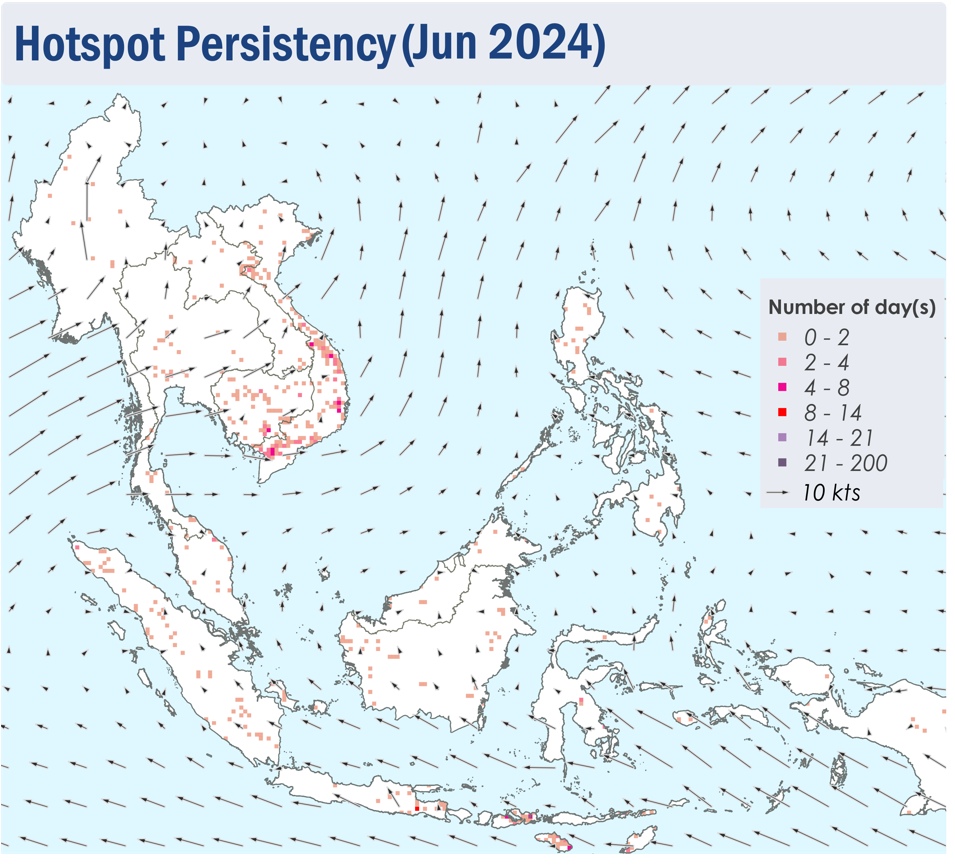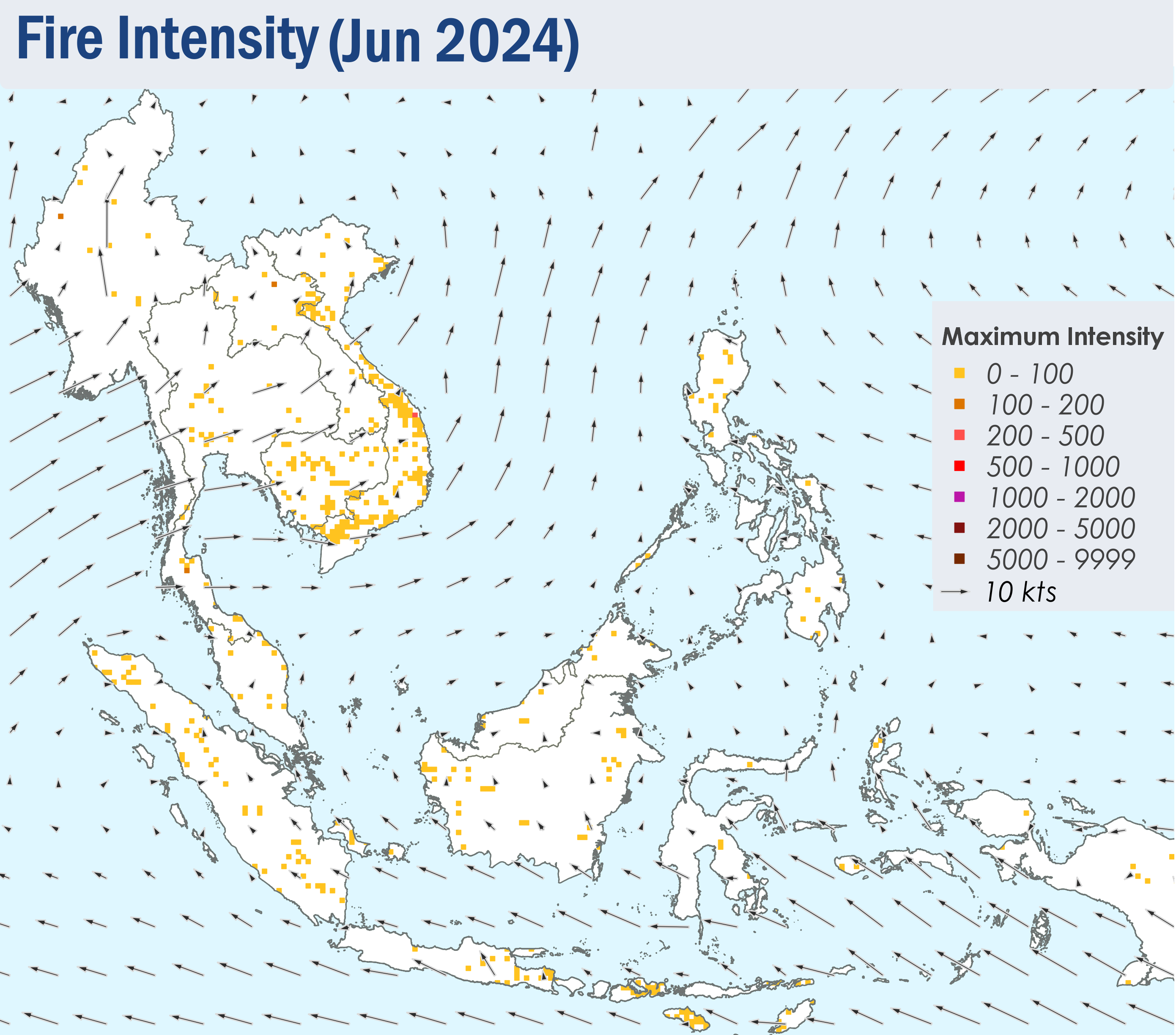Review of Regional Haze Situation for November 2024
1.1 Northeast monsoon conditions emerged over the ASEAN region during November 2024 as the prevailing low-level winds over the Mekong sub-region, Peninsular Malaysia, Singapore and the Philippines blew from the northeast or east. Light and variable winds were still observed over areas south of the Equator and the northern parts of the Mekong sub-region (Figure 1).
1.2 Drier conditions were observed over most parts of the Mekong sub-region except for isolated showers recorded over Myanmar and the southern parts of Viet Nam. Showers were observed over most parts of the southern ASEAN region with intense rainfall recorded over southern Thailand and the eastern coastal regions of Peninsular Malaysia where floodings were reported (Figure 1). Intense rainfall was also recorded in the northern parts of the Philippines under the influence of multiple Typhoons and Super Typhoons which led to floodings and landslides in the area.
1.3 The overall hotspot counts in 2024 over the ASEAN region were lower than or comparable to previous years, except for Viet Nam where the hotspot count was slightly higher.
1.4 Persistent isolated hotspots were mostly detected in the central parts of Thailand and Myanmar, as well as the northern and central parts of Viet Nam.
November 8, 2024
Review of Regional Haze Situation for October 2024
Review of Regional Haze Situation for October 2024
1.1 In October 2024, the Southeast Monsoon transitioned to the inter-monsoon conditions. As the monsoon rainband shifted towards the Equator, the winds over the equatorial regions became light and variable in direction (Figure 1). However, strong winds affected the northern parts of the Philippines at times, driven by Tropical Storm Trami and Super Typhoon Kong-Rey (Figures 8 and 9).
1.2 Showers prevailed over most of the ASEAN region in October 2024, apart from Java, the Lesser Sunda Islands and the northern and central parts of the Mekong sub-region where conditions were relatively drier (Figure 1). On 14 October 2024, ASMC downgraded the Alert Level for the southern ASEAN region from Level 1 to Level 0, following increased shower activity, marking the end of the dry season of the region. Towards the end of the month, heavy rainfall affected the northern and central parts of the Philippines, influenced by Tropical Storm Trami and Typhoon Kong-Rey, which were located over the northern South China Sea and the northwestern Pacific Ocean, respectively (Figures 8 and 9).
1.3 Over the ASEAN region, hotspot counts in October 2024 were generally comparable or lower than the same month of previous years (Figure 2 and 3) except in Thailand where the highest hotspot counts over the past five years was recorded. Despite this, the overall hotspot activity in the northern ASEAN region remained relatively low compared to previous years.
1.4 During the second half of October 2024, persistent and intense hotspots were detected mostly in the central and southern parts of Sumatra, the central and southeastern parts of Kalimantan and parts of Sulawesi and the Lesser Sunda Islands (Figure 4 and 5). Slight localised smoke plumes were observed to emanate from hotspots detected in the southeastern parts of Kalimantan and the southern parts of Sumatra (Figure 6 and 7).
October 8, 2024
Review of Regional Haze Situation for September 2024
Review of Regional Haze Situation for September 2024
1.1 Southwest Monsoon conditions persisted in September 2024 as the prevailing winds blew mainly from the southeast over areas south of the Equator and turned to blow from the southwest or west over areas north of the Equator (Figure 1).
1.2 Rainy conditions prevailed over most parts of the ASEAN region in September 2024, except for parts of Kalimantan, Sumatra, Java and the Lesser Sunda Islands which saw occasional dry weather . The month was marked by the occurrences of multiple tropical cyclones/typhoon, with Typhoon Yagi being the most notable one, which formed during the first week of the review period, and later Tropical Storm Soulik , which formed during the middle of the month. Heavy rain and strong winds brought by the storms affected large parts of northern Philippines and the northern parts of Viet Nam as they made landfall over both countries, resulting in significant damage to infrastructures and loss of life (Figure 1).
1.3 In September 2024, overall hotspot activity in the southern ASEAN region were generally comparable to previous years. Over Kalimantan, the hotspot counts in 2024 were as high as in 2023 (Figure 2) . For the northern ASEAN region, hotspot counts were lower or comparable to the same period in previous years (Figure 3).
1.4 Isolated to scattered hotspots were detected in Sumatra, Kalimantan, Java and the Lesser Sunda Islands on multiple days during the review period, with more intense and persistent hotspots located mostly in Kalimantan (Figure 4 and 5). Slight to moderate smoke haze was observed over parts of West Kalimantan, while localised smoke plumes were seen emanating from hotspots in other parts of Kalimantan, as well as from hotspots in the central and southern parts of Sumatra (Figure 6, 7 and 8). Smoke haze from West Kalimantan was also observed to drift into western Sarawak on some days during the review period. While the hotspot activity in the Mekong sub-region was suppressed, isolated hotspots were detected mostly in the central parts of Viet Nam (Figure 4 and 5).
September 23, 2024
Review of Regional Haze Situation for August 2024
Review of Regional Haze Situation for August 2024
1.1 1.1 Southwest Monsoon conditions prevailed over the ASEAN region in August 2024. The prevailing winds over regions south of the Equator blew mainly from the southeast while the prevailing winds over areas north of the equator blew mainly from southwest to west, with winds turning southerly near the Equator (Figure 1). With the occurrence of Tropical Storms and Typhoons mainly over the northwestern Pacific Ocean, winds over the northern parts of the Philippines would occasionally blow from the east.
1.2 It was a generally wet August with rainfall observed over most areas of the ASEAN region, with higher rainfall over the northern parts of the Mekong sub-region, Sumatra and Borneo and parts of the Philippines and Papua. Flooding and landslides were reported in multiple areas of Thailand during the month (Figure 1). In contrast, drier conditions were observed over Java, the Lesser Sunda Islands, Sulawesi as well as the southern parts of Sumatra (Figure 1).
1.3 During August 2024, the hotspot count in the ASEAN region was comparable to that of previous years (Figure 2 and 3), except for Viet Nam where the hotspot count in August 2024 is the highest compared to the same month of previous years (Figure 2).
1.4 In August 2024, isolated to scattered hotspots were mainly detected in parts of the southern ASEAN region, particularly in Java, the Lesser Sunda Islands, the southern parts of Sumatra and the western parts of Kalimantan where hotspot persistency and fire intensity were more pronounced (Figure 4 and 5). Slight to moderate smoke haze was observed over the western parts of Kalimantan, while smoke plumes were observed over the southern parts of Sumatra (Figure 6). While the hotspot activity in the Mekong sub-region was suppressed, isolated hotspots with high persistency and intensity were detected mostly in the central parts of Viet Nam (Figure 4 and 5).
August 6, 2024
Review of Regional Haze Situation for July 2024
Review of Regional Haze Situation for July 2024
1.1 In July 2024, the Southwest Monsoon conditions continued over the ASEAN region. Over the northern ASEAN region, the prevailing winds blew mostly from the southwest to west. In the southern ASEAN region, the prevailing winds over areas near the Equatorial region were observed to be generally weak and variable in direction while southeasterly winds were observed over the rest of the region (Figure 1).
1.2 Showers were observed over most of the ASEAN region during the review period, apart from Java and the Lesser Sunda Islands where dry conditions were observed (Figure 1). Parts of Peninsular Malaysia, Sumatra, and Kalimantan also experienced drier conditions during the latter half of the review period. On 17 July 2024, the Alert Level 1 for the southern ASEAN region was activated, signalling the start of the traditional dry season for the region. Over the northern ASEAN region, heavy rainfall was recorded over the northern parts of the Philippines due to the influence of Tropical Storm Prapiroon and Typhoon Gaemi situated over the northern parts of the South China Sea and the northwest Pacific Ocean respectively during the latter half of July (Figure 9 and 10). Rainfall was also observed to be high over the western coastal areas of Myanmar (Figure 1).
1.3 Over the southern ASEAN region, the hotspot counts were generally lower or comparable to previous years, except for the hotspot counts in Sumatra which was the highest compared to the past 5 years (Figure 2). Nonetheless, the hotspot activity for the southern ASEAN region remained relatively low compared to other parts of the year. Over the northern ASEAN region, the hotspot counts were lower or comparable to the past few years (Figure 3).
1.4 Hotspot activities were intense and persistent especially in the western parts of Kalimantan and parts of Sumatra towards the end of July 2024 (Figure 4). Slight to moderate localised smoke plumes were observed to emanate from hotspots detected in the western and central parts of Kalimantan and parts of Sumatra (Figure 5, 6, 7 and 8).
July 18, 2024
Review of Regional Haze Situation for June 2024
Review of Regional Haze Situation for June 2024
1.1 Southwest Monsoon conditions were fully established over the ASEAN region in June 2024. Over the Philippines and much of the southern ASEAN region, the prevailing winds blew mainly from the southeast. The prevailing winds over the Mekong sub-region were mostly southwesterly or westerly while the regions close to the Equator experienced winds that were mostly light and variable in direction (Figure 1).
1.2 During the review period, rainy weather prevailed over most parts of the ASEAN region. In particular, moderate to heavy showers fell on several days over the Philippines, southern Myanmar and northern Viet Nam. Drier conditions were observed over Java and the Lesser Sunda Islands (Figure 1).
1.3 Hotspot activity in the ASEAN region was mostly subdued in June 2024 due to the prevailing wet weather conditions. The total number of hotspots were lower or comparable to previous years of the same period (Figure 2 and 3).
1.4 In June 2024, a few to isolated hotspots were detected in the ASEAN region, particularly in the southern and central parts of Viet Nam where the fires were more persistent and intense(Figure 4 and 5). There was no significant smoke haze observed via satellite imagery and ground reports.
June 14, 2024
Review of Regional Haze Situation for May 2024
Review of Regional Haze Situation for May 2024
1.1 In early May 2024, the prevailing winds, especially over the Mekong sub-region and the South China Sea, were light and variable as inter-monsoon conditions continued. Prevailing winds for areas located south of the Equator then transitioned into southeasterlies from mid-May onwards, indicating the development of the Southwest Monsoon. Winds located to the east of the Philippines continue to be easterly in May 2024. (Figure 1).
1.2 Rainfall was observed over most of the ASEAN region except for Java and the Lesser Sunda Islands, where conditions were drier. The increase in precipitation in the Mekong sub-region compared to April 2024 resulted in the reduction of hotspots in the sub-region. (Figure 1) The Alert level was downgraded to Level 2 on 6 May, Level 1 on 13 May and subsequently Level 0 on 23 May, signaling the end of the dry season for the Mekong sub-region.
1.3 The hotspot count in May 2024 for Peninsular Malaysia, Sabah and Sarawak were higher when compared to previous years. However, for Kalimantan and Sumatra, the hotspot counts for May 2024 were lower. (Figure 3). Elsewhere in the ASEAN region, especially in the Mekong sub-region, the number of hotspots remain comparable with previous years.
1.4 In May 2024, isolated to scattered hotspots were detected mainly in the Mekong sub-region and the Philippines, especially in the northern parts of Lao PDR and the southern parts of Myanmar where fire intensity and hotspot persistency were more pronounced. (Figure 4 and 5) During early May, moderate to dense transboundary smoke haze was observed over the northern parts of Lao PDR, the northern parts of Thailand, as well as the eastern and southern parts of Myanmar. The transboundary smoke haze was shown to drift in the north-east direction into the northern parts of Viet Nam and Lao PDR (Figure 6 and 7).
1.5 Hotspot activity remained mostly subdued in the southern ASEAN region except for a few persistent hotspots in the eastern parts of Peninsular Malaysia (Figure 4). Localised smoke plumes were observed to emanate from these hotspots on some days. (Figure 8)
May 13, 2024
Review of Regional Haze Situation for April 2024
Review of Regional Haze Situation for April 2024
1.1 In April 2024, the prevailing winds over areas near the Equator turned light and variable in direction as the monsoon rainband shifted northwards towards the Equator. This is characterised with the transition of the Northeast Monsoon to the inter-monsoon conditions. Over the northern ASEAN region, the prevailing winds over the Philippines blew mostly from the northeast or east. While the prevailing winds over the northern parts of the Mekong sub-region were light and variable in direction, the prevailing winds over the rest of the sub-region blew mostly from the south or southwest (Figure 1).
1.2 Although some rainfall was observed over the northern, southeastern and central parts of the Mekong sub-region as well as the southern parts of the Philippines on a few days, dry conditions persisted over the northern ASEAN region on most days of the review period. The southern ASEAN region experienced wet weather on most days of the outlook period, except for the eastern parts of Borneo and the northern parts of Peninsular Malaysia and Sumatra where conditions were drier (Figure 1).
1.3 During the review period, the hotspot counts over the Mekong sub-region in April 2024 were largely higher or comparable to recent years (Figure 2). Over the southern ASEAN region, hotspot counts for Kalimantan and Malaysia in April 2024 were higher compared to previous years, but still relatively low compared to during the dry season. Elsewhere in the region, the hotspot counts were comparable to previous years (Figure 3).
1.4 In April 2024, scattered to widespread hotspots continued to be detected in the Mekong sub-region, with more intense and persistent clusters of hotspots in Lao PDR, various parts of Myanmar, northern Thailand and the northeastern parts of Cambodia (Figure 4 and 5). During most days of the review period, widespread moderate to dense transboundary smoke haze was observed to cover the eastern parts of Myanmar, northern and central parts of Thailand, and the northern parts of Lao PDR and Viet Nam (Figure 6 and 7). Moderate to dense smoke haze was also observed over other parts of Myanmar, Cambodia, and the eastern parts of Thailand (Figure 6). Moderate smoke plumes emanating from the hotspot clusters detected in the southern and central parts of Lao PDR were observed to drift northeastwards into the central parts of Viet Nam on a few days (Figure 6 and 8).
1.5 While the hotspot activity over the southern ASEAN region remained low, there were a few more intense and persistent hotspots detected in the eastern coastal areas of Peninsular Malaysia and the eastern parts of Kalimantan (Figure 4 and 5). Localised moderate smoke plumes (Figure 6, 9 and 10) were observed to emanate from these hotspots on some days.
April 5, 2024
Review of Regional Haze Situation for March 2024
Review of Regional Haze Situation for March 2024
1.1 The Northeast Monsoon conditions continued over the ASEAN region in March 2024. Over areas north of the equator, the prevailing winds blew mainly from the east to northeast although light and variable winds prevailed over most parts of the Mekong sub-region. The prevailing winds over areas south of the Equator blew mostly from the west or northwest. As the Northeast monsoon conditions gradually weakened in the last week of the month, the prevailing winds over most of the ASEAN region started to turn light and variable on several days during the review period. (Figure 1).
1.2 The Mekong sub-region remained dry throughout the review period of March 2024, except for isolated shower activities in some parts of the sub-region on a few days. Elsewhere in the ASEAN region, generally wet conditions were observed in many areas, except for parts of Peninsular Malaysia, northeastern Borneo and the Philippines where there were brief periods of drier weather (Figure 1).
1.3 Over the Mekong sub-region, the hotspot counts in March 2024 were either lower or comparable to previous years (Figure 2). Over the southern ASEAN region, the hotspot counts were higher or comparable to the past few years, with an increase in Kalimantan, Peninsular Malaysia as well as Sabah and Sarawak. Kalimantan, Sabah and Sarawak recorded the highest hotspot count over 5 years (Figure 3), although the hotspot count for the southern ASEAN region during the review period remained relatively low.
1.4 Scattered to widespread hotspots were detected over many areas of the Mekong sub-region in March, with more intense and persistent clusters of hotspots in eastern Myanmar, Lao PDR, northern Thailand, and northeastern Cambodia. (Figure 4 and 5). Widespread transboundary moderate to dense smoke haze was observed mainly in the vicinity of the hotspot clusters in eastern Myanmar, northern and central Thailand, Lao PDR, as well as northern Cambodia and northern Viet Nam (Figure 6 and 7) on many days. With the deteriorating hotspots and haze situation, Alert Level 3 was issued for the Mekong sub-region on 6 Mar 2024. For the southern ASEAN region, localised moderate smoke plumes were also observed emanating from a few hotspots in eastern Peninsular Malaysia on some days during brief dry periods.
March 8, 2024
Review of Regional Haze Situation for February 2024
Review of Regional Haze Situation for February 2024
1.1 1.1 The ASEAN region continued to experience Northeast Monsoon conditions in February 2024. Over areas north of the Equator, the prevailing winds blew mainly from the northeast except over the Mekong sub-region where the winds were mostly light and variable in direction. Over areas south of the Equator, the prevailing winds blew mostly from the northwest or north (Figure 1).
1.2 1.2 The Mekong sub-region remained dry throughout the review period of February 2024, with moderate to dense haze observed over many parts of the sub-region (Figure 6) on several days. On 7 February 2024, the Alert Level 2 for the Mekong sub-region was activated in view of the increasing hotspots and risk of transboundary haze in the Mekong sub-region. Showers were observed elsewhere in the ASEAN region, except for parts of Peninsular Malaysia and the Philippines where there were brief periods of drier weather. The overall hotspot and haze situation in the southern ASEAN region and the Philippines stayed subdued (Figure 1).
1.3 1.3 Over the Mekong sub-region, the hotspot counts in February 2024 were comparable to previous years (Figure 2). Over the southern ASEAN region, the hotspot counts were higher or comparable, with a rise in Kalimantan, Peninsular Malaysia as well as Sabah and Sarawak compared to the past few years. Sabah and Sarawak recorded the highest hotspot count over 5 years (Figure 3), although the hotspot count for the southern ASEAN region during the review period remained relatively low.
1.4 1.4 Hotspot activities were persistent over many areas of the Mekong sub-region in February, with fires of higher intensity observed mainly over parts of Lao PDR and northeastern Cambodia (Figure 4 and 5). Moderate to dense smoke haze was observed mostly in the northern, western, and central parts of the sub-region (Figures 6, 7 and 8).




